The lasting pleasures of second-tier golden age Universal horror movies
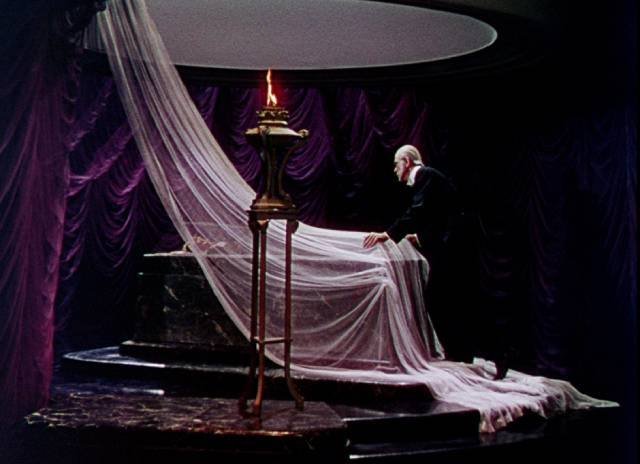
For several years Eureka has been releasing sets of genre B-movies from the ’30 and ’40s. I think the first was their collection of three Poe adaptations featuring Bela Lugosi, followed by the six movies Boris Karloff made at Columbia and Universal’s six Inner Sanctum movies starring Lon Chaney. I recently caught up with – and binged – three more sets of Universal programmers spanning from 1933 to 1952. They cover a range of budgets and reflect changes in censorship and marketing which affected horror as the Production Code and audience tastes evolved through the Depression and Second World War. Perhaps most interestingly, they throw some light on the evolution of Universal Studios as it weathered economic difficulties and changes in ownership and management in the ’30s and eventually merged with International Pictures in 1945 to become Universal-International, which revived the studio’s genre credibility a few years later with their sci-fi/horror movies of the ’50s.
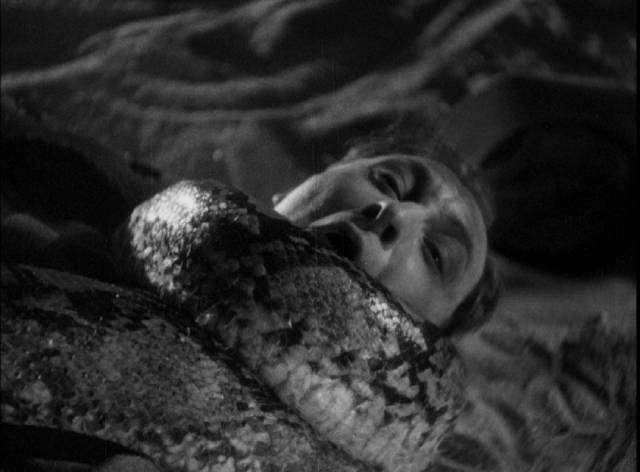
Although there had been occasional successful horror movies throughout the 1920s, it was Universal’s early talkie double success with Tod Browning’s Dracula and James Whale’s Frankenstein in 1931 which launched the genre as a viable commercial investment. In the next few years, the studio produced many horror movies, with other studios following suit – Paramount with Rouben Mamoulian’s Dr. Jekyll and Mr. Hyde (1931) and Erle C. Kenton’s Island of Lost Souls (1932), MGM with Charles Brabin’s The Mask of Fu Manchu, Tod Browning’s Freaks (both 1932) and Karl Freund’s Mad Love (1935), Warners with Michael Curtiz’s Dr. X (1932) and Mystery of the Wax Museum (1933), RKO with Irving Pichel’s The Most Dangerous Game (1932). Even poverty row producers joined in with movies like Victor Halperin’s White Zombie (1932) and Dwain Esper’s Maniac (1934). But this first Golden Age was actually quite brief.
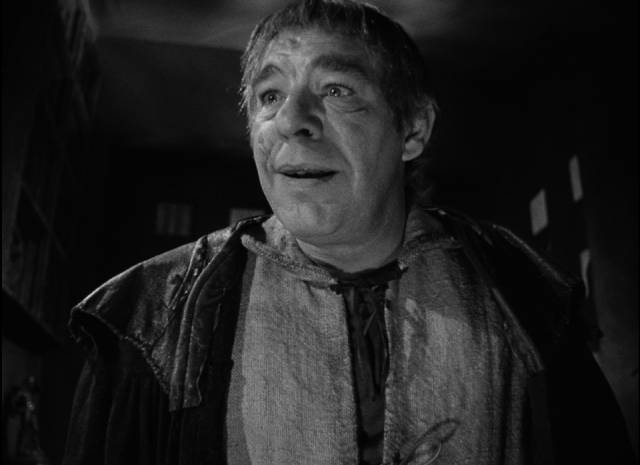
Guardians of the public morality were generally appalled by the genre. Certainly, in the pre-Code years filmmakers pushed the boundaries of taste, with movies awash with perverse undertones, violence and various pathologies. The sexually-charged sadism in movies like Island of Lost Souls and Tod Browning’s Freaks still has the power to disturb almost a hundred years after they were made. So by the mid-’30s, increasing constraints on content and declining interest from an audience battered by the Depression saw horror being replaced by other genres – musicals, comedies, gangster movies.
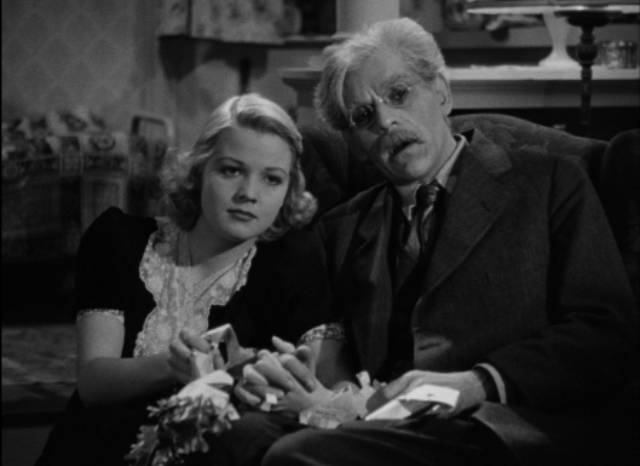
Universal itself ran into major difficulties when their prestige production of Show Boat (1936), ironically directed by James Whale who had helped to put them on the industry map just a few years earlier, went over budget, forcing the company to take out a hefty loan which they were unable to repay. This led Standard Capital Corporation to seize control, ousting Carl Laemmle and his son Carl Jr. from their controlling positions – and making Universal one of, if not the first case of a production company being taken over by financial people whose interest wasn’t in the movies themselves but rather only in the manufacture of a product from which to extract profit. J. Cheever Cowdin of Standard Capital took over as president and chairman of the board, his first act being to cut production budgets, turning away from the Laemmles’ ambitions for more prestige and redirecting the company towards cheap programme pictures.
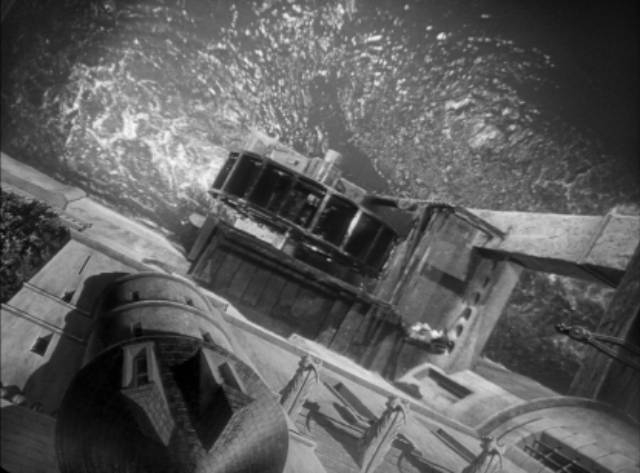
At the time, horror wasn’t profitable and so the company which had launched the genre turned away from it for a few years – until the re-release of Frankenstein and Dracula on a double bill in 1939 proved to Cowdin that there was after all still some life in the company’s monsters and he green-lit Son of Frankenstein, which was given a relatively substantial budget and proved to be a worthy successor to Whale’s Frankenstein and Bride of Frankenstein (1935). And so the studio once again was in the horror business, though few of their subsequent productions were as lush as the Frankenstein reboot, particularly as resources became more limited with the start of the war, and apart from The Wolf Man and one or two others, these movies quickly descended into self-parody which eventually led to the series of Abbott and Costello Meet… comedies.
*
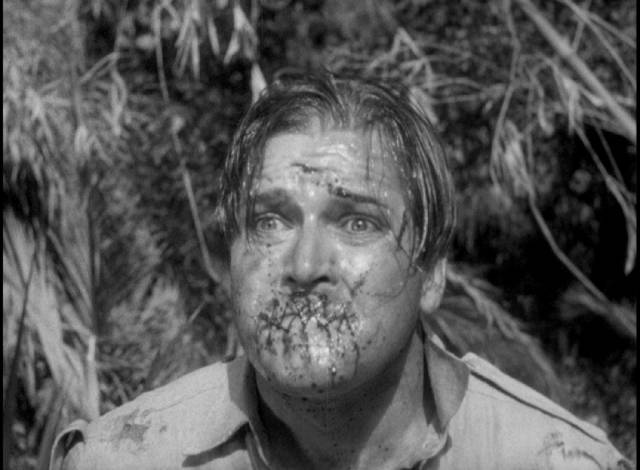
Murders in the Zoo (A. Edward Sutherland, 1933)
Even at the height of Universal’s first run of horror movies, the people in charge weren’t entirely sure of the genre. While they allowed Edgar G. Ulmer to make his perverse masterpiece The Black Cat (1934) without apparent interference, they made a mess of Robert Florey’s Murders in the Rue Morgue (1932), re-cutting it into narrative incoherence (a reconstruction of Florey’s original cut is included on Eureka’s disk on the Poe-Lugosi set). The title of Murders in the Zoo (1933) suggests an attempt to cash in on the familiarity of the Poe title, but the result is even more of a mess than the release version of Florey’s film. Much of the blame can be laid on the script (written by Philip Wylie, Seton I. Miller and Milton Herbert Gropper), but perhaps more belongs to the assignment of A. Edward Sutherland as director. Perhaps best-known for his comedies – following this, he immediately made International House (1932) with W.C. Fields, going on to work with Fields again in Poppy (1936) and Laurel and Hardy in The Flying Deuces (1939) – Sutherland leans hard on comedy here, undermining the story’s horror potential at every turn.
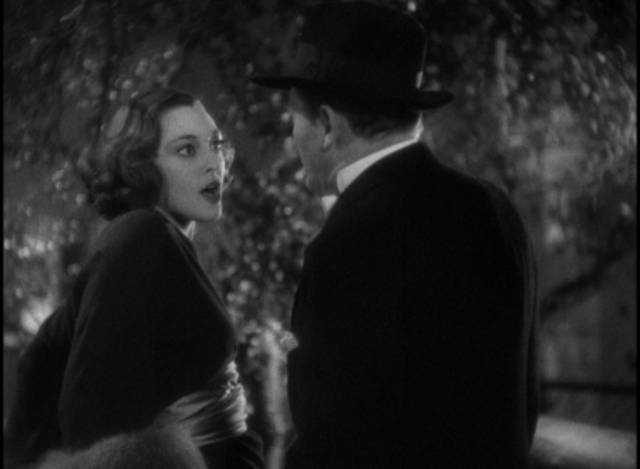
This is unfortunate, because Murders in the Zoo opens with a sequence as shocking as anything in The Black Cat. Wealthy big game hunter Eric Gorman (Lionel Atwill) is on an expedition in Asia gathering animals for a zoo back in the States. We first meet him as his bearers hold down Bob Taylor (Edward Pawley) as Gorman sews his mouth shut and then turns him loose in the jungle – the image of Taylor stumbling towards the camera in terror, bloody and unable to scream, is genuinely nightmarish. The man’s crime was being caught in camp attempting to kiss Gorman’s wife Evelyn (Kathleen Burke), something the pathologically possessive Gorman considers worthy of a death sentence.
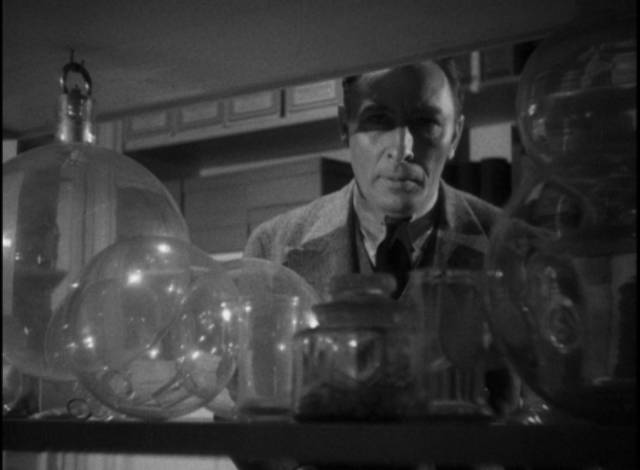
On the voyage home, Roger Hewitt (John Lodge) tries to persuade Evelyn to leave Gorman, but she’s too afraid, knowing what he’s capable of. Then, having set up this tense triangle and established the very high stakes involved, the movie abruptly shifts gears and introduces Peter Yates, a newspaperman whose career has stalled due to alcoholism. He’s applying for a job as press agent for the zoo. Hired by zoo director Professor G.A. Evans (Harry Beresford), Yates inexplicably becomes the main character, comedian Charlie Ruggles playing him as a nervous, bumbling schmuck who’s terrified of animals. With the comic relief foregrounded, the twisted tale of marital abuse and murder is drained of much of its impact, despite the psychopathic Gorman killing Hewitt at a crowded dinner, feeding Evelyn to a pool full of alligators and implicating researcher Dr. Jack Woodruff (Randolph Scott) in the crimes.
It was quite common in the early sound era for movies to mix genres, as if rules had not yet been firmly codified, but here the discordance between elements is grating. Popular though he might have been, Charlie Ruggles’ intrusive presence quickly becomes tedious and even Lionel Atwill, capable of formidable villainy, finds himself treated almost as an afterthought.
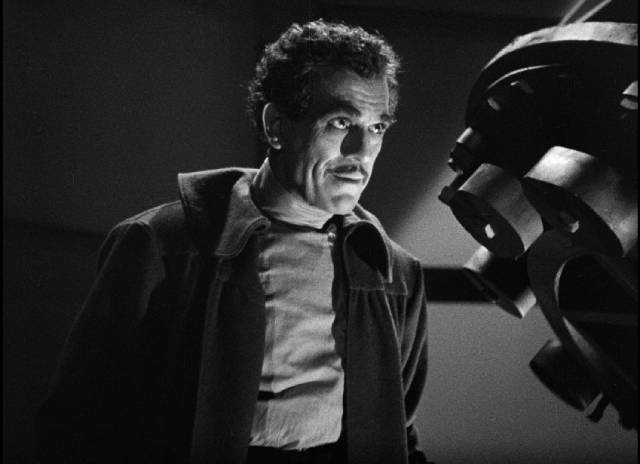
The Invisible Ray (Lambert Hillyer, 1936)
Given the commercial success of both Dracula and Frankenstein, it’s not surprising that Universal paired Boris Karloff and Bela Lugosi in a number of movies in the ensuing decade, with varying degrees of success. The two actors had something of a rivalry, and with Karloff managing his career more astutely, Lugosi resented the increasingly uneven status they held in the business. But in two of their best collaborations, it was Lugosi who surprisingly had the more sympathetic role – in The Black Cat, he is the victim of Karloff’s sadistic psychopath, while in Lambert Hillyer’s The Invisible Ray (1936) he is the altruistic doctor who uses the discovery of the radioactive element Radium X to heal, while Karloff as the element’s discoverer goes over to the dark side and uses his new-found power to murder those he feels have wronged him.
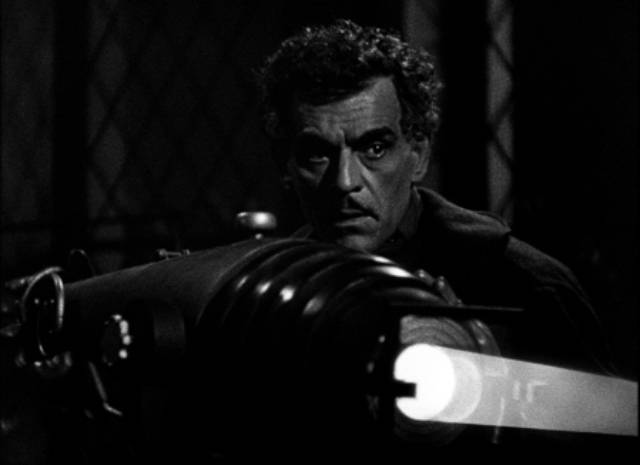
Dr. Janos Rukh (Karloff) has become something of a scientific pariah because of his theories, but he manages to convince several other doctors, including Dr. Felix Benet (Lugosi), that he has pinpointed the site in Africa where a meteor crashed millions of years ago. On a joint expedition, the group go looking for the extraterrestrial rock, but when Rukh finds it, he’s contaminated by the powerful radiation – glowing in the dark, his touch becomes fatal. Benet manages to concoct an antidote which suppresses the effect temporarily, and he takes a sample back to Paris while Rukh continues his studies.
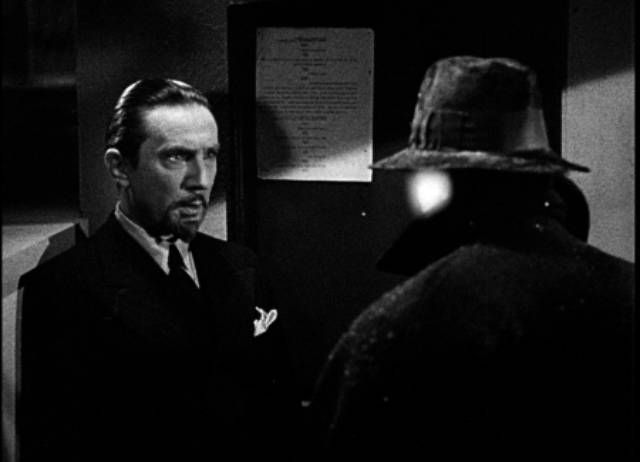
As Benet finds ways to use the discovery to heal pretty much anything from blindness to cancer, the poison works its way into Rukh’s brain and when he finds out that his discovery, about which he feels extremely proprietary, is now a public sensation, he determines to destroy not only Benet, but everyone else involved, including his own wife Diana (Frances Drake). In effect early science fiction as much as horror, The Invisible Ray seems prescient, looking forward to the ’50s movies made in the wake of the development of the atom bomb, presenting two possible paths for the use of radioactive elements. That it clearly states that the destructive use of Radium X is rooted in madness serves as a warning about what would arrive less than ten years later in the desert at Los Alamos.
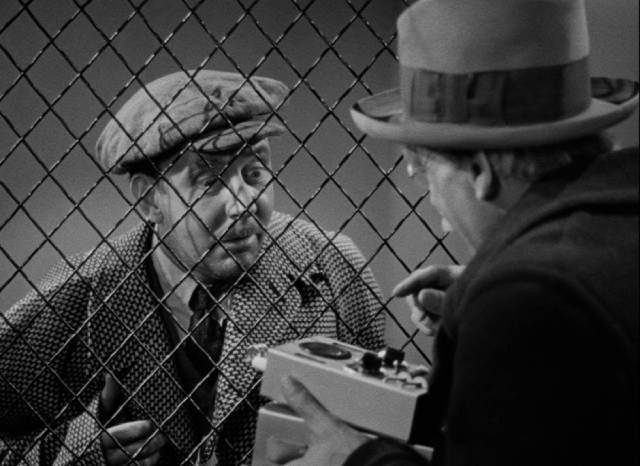
Night Key (Lloyd Corrigan, 1937)
A sci-fi gadget also figures prominently in the very minor Night Key (1937), the next-to-last movie directed by Lloyd Corrigan before he settled into a prolific three-decade acting career. Karloff plays David Mallory, an aging, mild-mannered inventor with a poor business sense. He was cheated years ago by his partner Stephen Ranger (Samuel S. Hinds), who barely compensated him for the security system he invented, which now protects many businesses in the city. Mallory has come up with a whole new system using electric eyes which, if put on the market, would render Ranger’s business hopelessly out of date. Weary and going blind, Mallory makes the foolish decision to go back to Ranger to try to sell him the new system. Needless to say, with the help of a crooked lawyer, Ranger cheats him again with a contract which prevents Mallory selling his device elsewhere while setting no date for replacing the existing system with the new one.
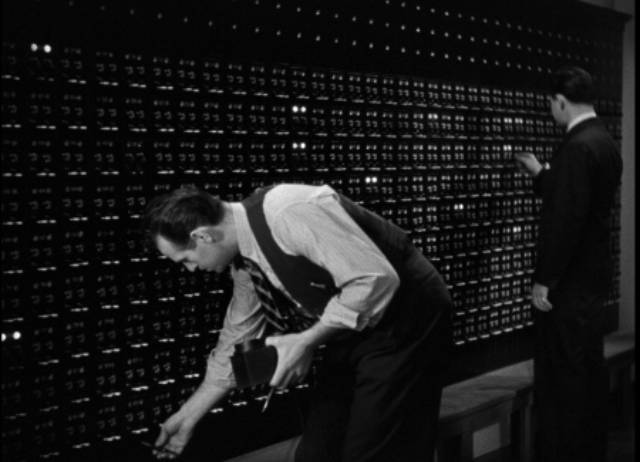
With time running out and wanting to leave his daughter Joan (Jean Rogers) some security, Mallory uses another device he has on hand, the “night key”, which neutralizes the old alarm system. With the help of small-time crook Petty Louie (Hobart Cavanaugh), he begins to break into the businesses protected by Ranger’s company, not stealing anything but just moving things around and leaving anonymous notes to let everyone know that they are no longer secure. Ranger knows who’s behind the break-ins and sends one of his men, Jim Travers (Warren Hull), to watch Joan until Mallory comes out of hiding.
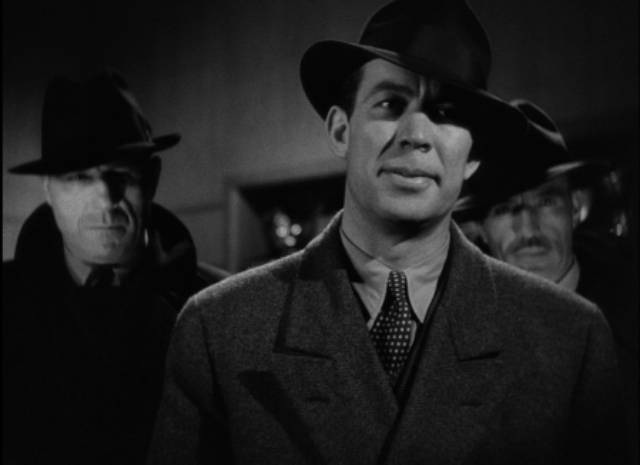
Unfortunately, a local gangster known as The Kid (Alan Baxter) gets wind of Mallory’s device and forces him to help with real burglaries. While Mallory tries to thwart The Kid’s plans and Ranger tries to save his business, Travers, realizing how his boss has abused the old inventor, falls for Joan and switches his allegiance. Although there’s some violence, it’s all rather lightweight and a bit sentimental (Karloff lays on the nice-old-man bit pretty heavily) and ends happily for all concerned (except The Kid of course), but Corrigan gives it a breezy pace.
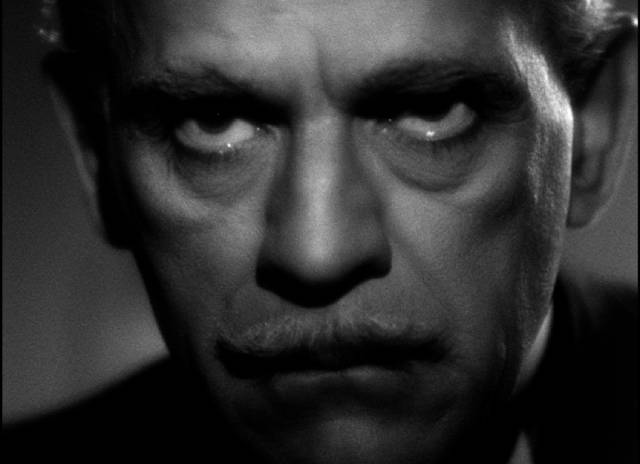
Black Friday (Arthur Lubin, 1940)
You don’t need to see the credits to know that Curt Siodmak had a hand in writing Black Friday (1940); no other writer so persistently addressed the idea of illicit brain transplants, most famously in his 1942 novel Donovan’s Brain (adapted many times), but the obsession may have started here, in this odd little B-movie made two years before that book was published. The rules are a bit murky, though, with the operation resulting in personalities bouncing back and forth a la Jekyll and Hyde – with very confusing physical transformations to go along with behavioural changes.
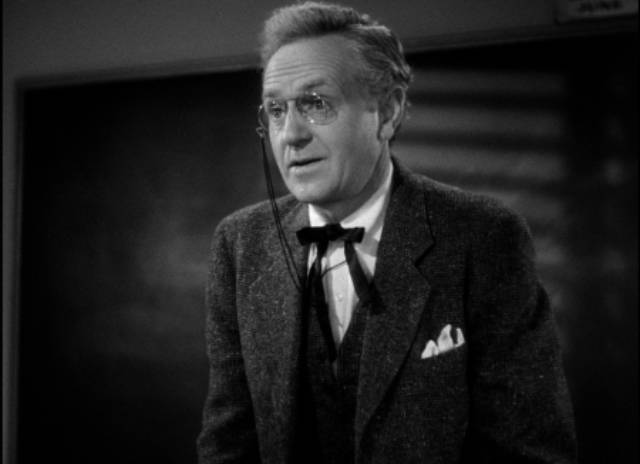
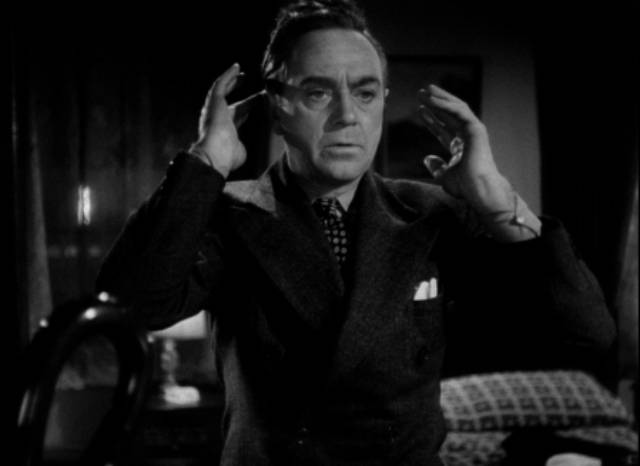
Dr. Ernest Sovac (Boris Karloff) has been tinkering with brains at a university in a small city, but his work has naturally been limited to animals. But when the speeding car of gangster Red Cannon crashes and leaves Sovac’s friend, kindly English prof George Kingsley (Stanley Ridges), critically injured, he sees an opportunity he can’t pass up. This is where I got confused, because his plan to save George involves transplanting Red’s brain into Kingsley’s body – or at least that’s how it comes across. And yet George’s personality remains intact after the operation. It’s very late in the movie when Sovac clarifies that what he did in fact was replace the damaged parts of George’s brain with pieces of Red’s, thus creating a hybrid with the two personalities vying for dominance. While this might explain the changes in George’s bearing depending on who’s in control, it doesn’t explain why his haircut changes, becoming darker and slicker every time Red emerges, nor how George’s eyes don’t need glasses when Red takes over.
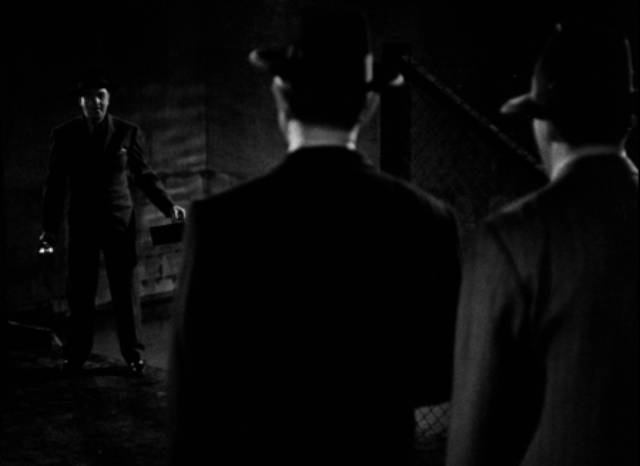
Less puzzling, but more morally problematic, are Sovac’s actions when he realizes what’s happening and he decides to take advantage of the situation as George recovers. The crash had occurred because a rival gangster was pursuing Red, determined to get hold of the loot from a bank robbery the whereabouts of which only Red knows. Sovac figures that if he can find that money himself, he’ll be able to build a lab where he can freely pursue his brain studies, so he takes George to the city and encourages Red to emerge. But Red has his own agenda and George, under his control, sets about murdering his rivals … which in turn leads the opposing gang leader, Eric Marnay (Bela Lugosi, relegated to a minor supporting role), back to George and Sovac.
This is perhaps the weakest of all Karloff-Lugosi pairings – they barely have anything to do with each other, and Lugosi is awkward as a tough New York gangster – with character actor Stanley Ridges unexpectedly dominating the movie in his dual role. Black Friday is more like the mad scientist movies Karloff made at Columbia than the other films he had been making at Universal.
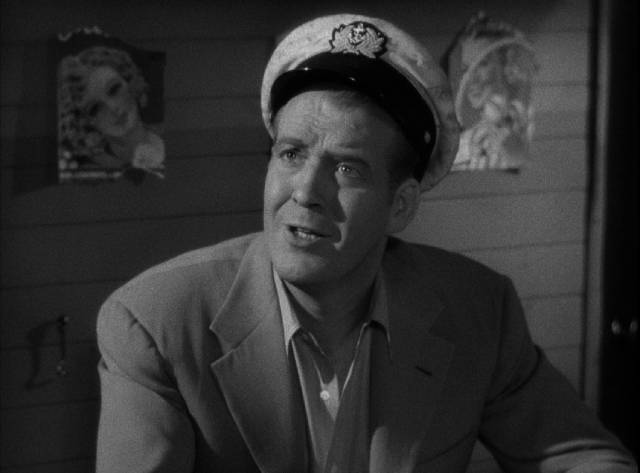
Horror Island (George Waggner, 1941)
Horror and comedy are natural partners, each aiming to evoke heightened emotions in a rhythm of tension and release, but when mixed it’s not always possible to find the right balance. Whether the comedy undercuts the horror to a point where it’s completely neutered or whether the horror remains so potent that the comedy acquires a nasty, callous edge, the results may end up satisfying neither. The old dark house genre tends to lean more towards comedy, often with the seemingly supernatural elements proving in the end to be faked in furtherance of some criminal activity. Such is the case with Horror Island (1941), a surprisingly tepid effort from George Waggner, who later the same year would, along with writer Curt Siodmak, establish the key parameters of the werewolf genre with The Wolf Man (1941).
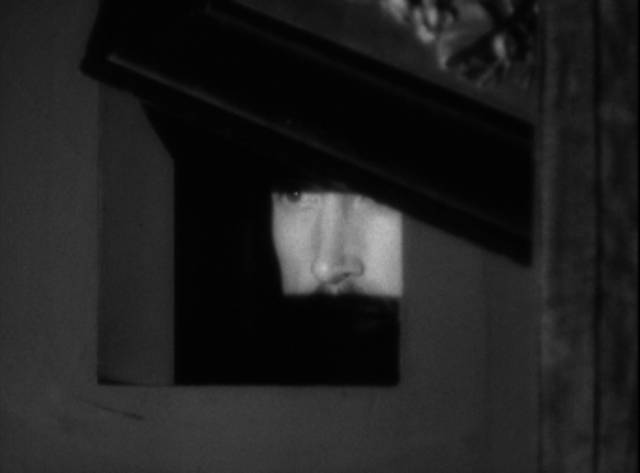
Here, a struggling businessman devises a scheme to sell adventure to gullible tourists in the form of a weekend on a remote island where pirate treasure is reputed to be hidden. He and his comic-relief sidekick have rigged the old mansion with a sound system and various tricks to spice things up, but as they settle in it appears that there’s a real phantom menace prowling the halls. There’s murder and their boat disappears, trapping everyone on the island. The spooky stuff is mild, the comedy lame, though cinematographer Elwood Bredell creates some visual atmosphere. Cast with studio stock company players, there’s really little to recommend and even at just an hour it seems to drag on.
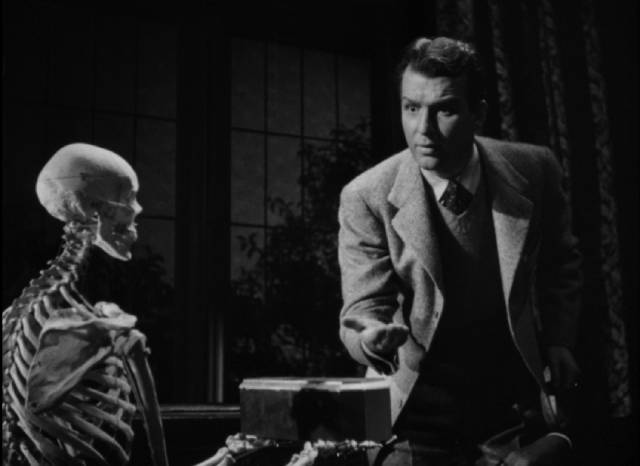
Night Monster (Ford Beebe, 1942)
Ford Beebe was a prolific director of serials – westerns, crime, science fiction – who occasionally also banged out low-budget B-movies. Despite a rather low reputation, his talent for energetic, entertaining pulp makes Night Monster (1942) one of the better impoverished productions from Universal’s Standard Capital years. Essentially an old dark house story, it actually has a genuine supernatural element driving the plot and eschews comic relief, giving it an enjoyably dark, creepy ambience.
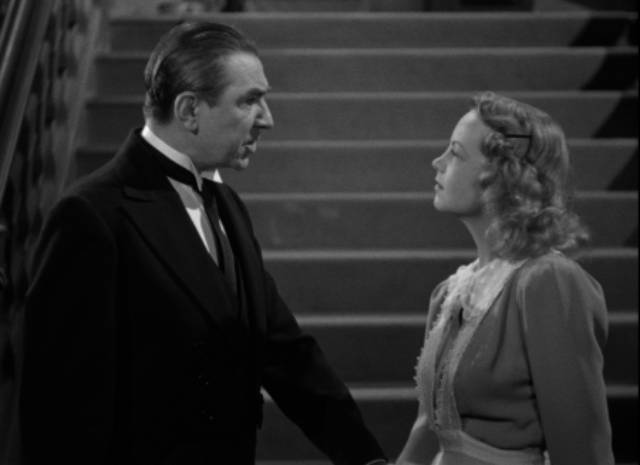
There have been a number of mysterious deaths out near the old Ingston place, which is situated by a swamp. Something sinister stalks people on the lonely country roads, its appearance preceded by the sudden silence of the swamp’s frogs and bird population. Locals are wary of the old house, but no one knows what’s really going on in there. It’s the home of Kurt Ingston (Ralph Morgan, yes the Wizard of Oz himself), who is confined to a wheelchair, having been crippled during life-saving treatments by a team of medical specialists. He’s attended by butler Rolf (Bela Lugosi), chauffeur Laurie (Leif Erickson), housekeeper Mrs. Judd (Doris Lloyd) and Indian mystic Agor Singh (Nils Asther). Also in the house is his sister Margaret (Fay Helm), watched closely by Mrs. Judd and designated as mentally unstable.
One night, at Ingston’s invitation, the three doctors whose treatment left him paralyzed arrive at the house, greeted in a friendly way by their former patient. But Drs. King (Lionel Atwill), Timmons (Frank Reicher) and Phipps (Francis Pierlot) are wary and a little defensive, uncertain of why they’ve been summoned. They are right to be suspicious; the house’s mysterious presence will target each of them during the night.
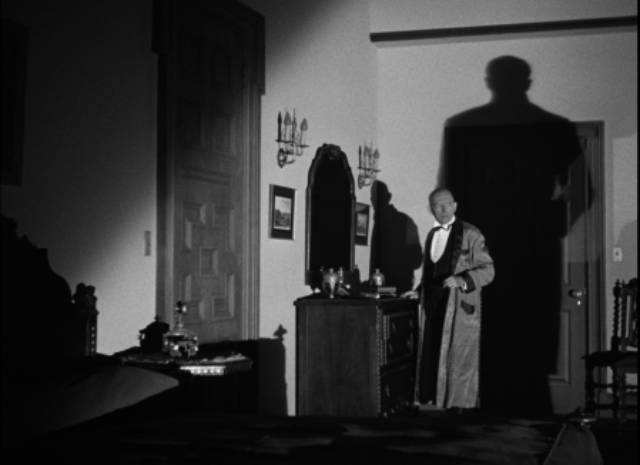
By coincidence, at the same time Dr. Lynne Harper (Irene Harvey) arrives, having been summoned by Margaret. She’s in the company of mystery writer Dick Baldwin (Don Porter), who found her stranded on the road after her car broke down, his arrival coinciding with that sudden sinister silence in the swamp. Lynne is greeted coolly, neither Ingston nor Judd happy to see her; they urge her to leave immediately, not wanting her to see Margaret, but with her car out of action she’s stuck there for the night. They have reason to keep her away from Margaret because Ingston’s sister has a good idea of what’s going on in the house.
Ingston has invited the doctors in order to demonstrate a metaphysical discovery, courtesy of Agor Singh, who has the power to bridge space and time with his mind, manifesting physical objects such as a Sicilian skeleton bearing a jewel case. Ingston himself has been studying this materialization technique so, as people start to die mysteriously, it’s not too difficult to figure out what’s going on – but when he’s finally revealed, walking on phantom legs as he pursues Lynne and Baldwin, he’s an unsettling sight.
With its better-than-average cast and Beebe’s brisk direction, Night Monster is a satisfyingly atmospheric little movie.
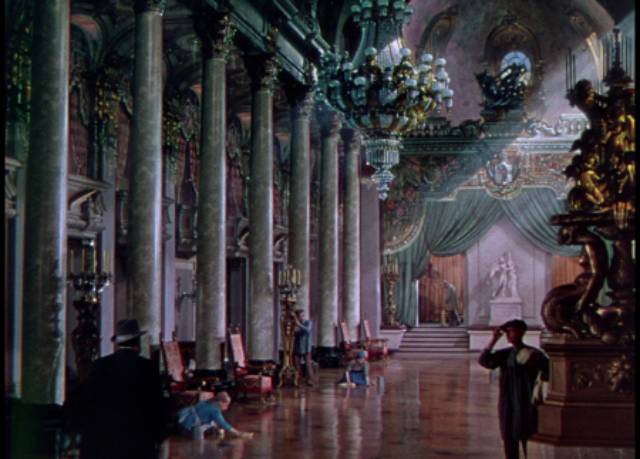
The Climax (George Waggner, 1944)
While many of Universal’s horror movies of this period seem a bit threadbare, in 1943 the company raised its sights and invested in a Technicolor remake of their silent spectacular The Phantom of the Opera (1925) which, despite its faults, featured one of Lon Chaney’s most striking make-ups. The remake lacked that distinctive quality, with Claude Rains a rather underwhelming Phantom. The movie was also weighed down by its obvious striving for “quality” under Arthur Lubin’s direction, and the foregrounding of musical numbers by Nelson Eddy and Susanna Foster repeatedly brought the plot to a standstill. And yet, it was a box office success, so the studio was encouraged to try again the following year.
Based on a 1909 play by Edward Locke, The Climax (1944) has obvious parallels with Phantom, though it inverts key elements. There are also echoes of George du Maurier’s 1894 novel Trilby, whose famous character Svengali is inverted in The Climax as Dr. Friedrich Hohner. Where both Phantom and Trilby feature powerful men who exert their influence over younger women to shape them into successful singers, Hohner perversely uses his own hypnotic power to destroy a promising young singer’s voice.
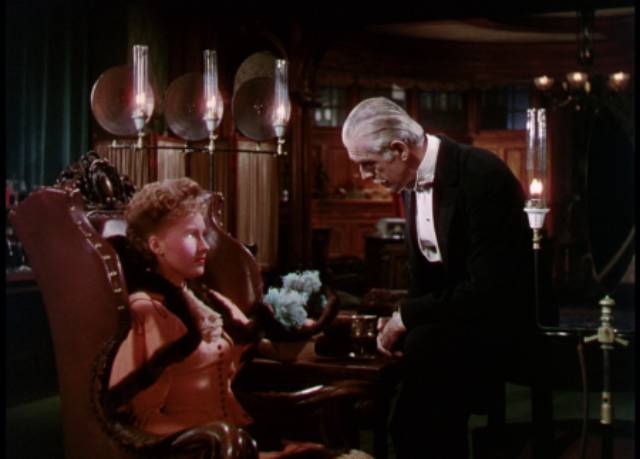
In the movie’s prologue, Hohner (Boris Karloff) finds his love for diva Marcellina (June Vincent) rejected and he blames the voice which is bringing her international success for taking her away from him. So he kills her and (we later discover) preserves her body in a secret room in his house around the corner from the opera house where he serves as the company’s physician. (Another echo here, of Karloff’s necrophile occultist Hjalmar Poelzig in Ulmer’s The Black Cat [1934].) Then, ten years later, he hears hopeful ingenue Angela Klatt (Susanna Foster) singing, accompanied on piano by her boyfriend Franz Munzer (Turhan Bey), and her voice is just like Marcellina’s. This impresses the opera manager Count Seebruck (Thomas Gomez), who envisions resurrecting Marcellina’s signature role for Angela.
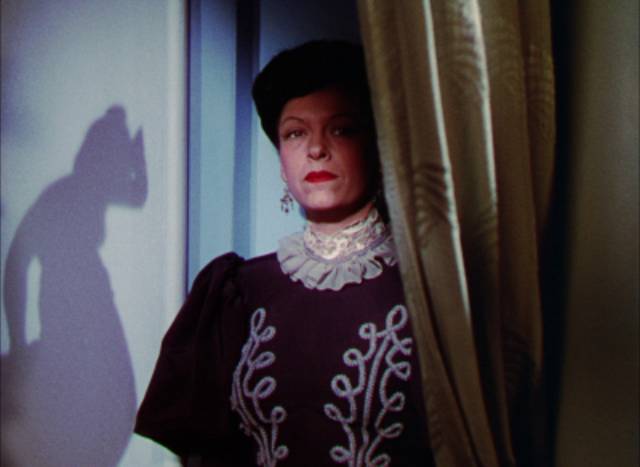
This pushes Hohner over the edge and, under the guise of examining her throat, he hypnotizes Angela and tells her that she can’t sing. With everyone puzzled by Angela’s new psychological block, it’s up to Franz to save her with the help of Marcellina’s former dresser Luise (Gale Sondergaard), who has spent the past ten years as the doctor’s housekeeper trying to discover what really happened to her mistress. It’s a race against time now to break Hohner’s hold over Angela before he can kill her to prevent her debut in a royal command performance. Naturally there’s a fiery climax and a triumph of true love. But along the way, the thin plot plods along, weighed down with several interminable musical numbers which we have to hear from start to finish.
Aiming for class, as in the Phantom remake, everyone seems crushed by the conflict between good taste and the demands of melodrama. But that said, Karloff is a welcome presence as the unhinged villain.
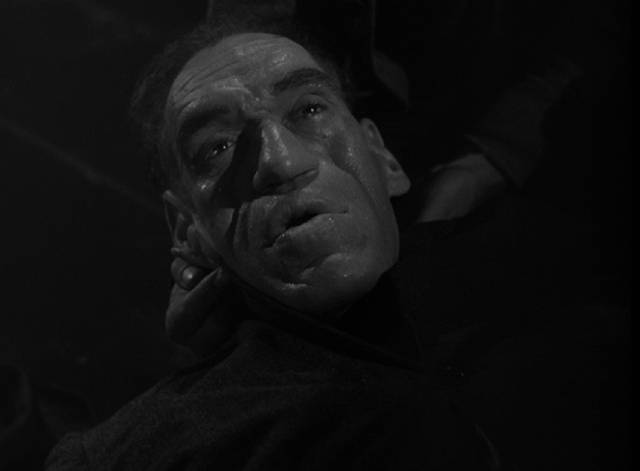
House of Horrors (Jean Yarbrough, 1946)
When The Climax proved less successful at the box office than Phantom of the Opera, Universal didn’t pursue that course any further, reverting to the low-budget black-and-white B-movie horrors which posed less of a financial risk. In the next two years, the company produced two dozen more of these before the second horror wave petered out. But thanks to personnel who had honed their skills through the previous decade, there were nonetheless a number of memorable releases, including Jean Yarbrough’s House of Horrors (1946), the first of four horror movies from this prolific but generally undistinguished studio journeyman.
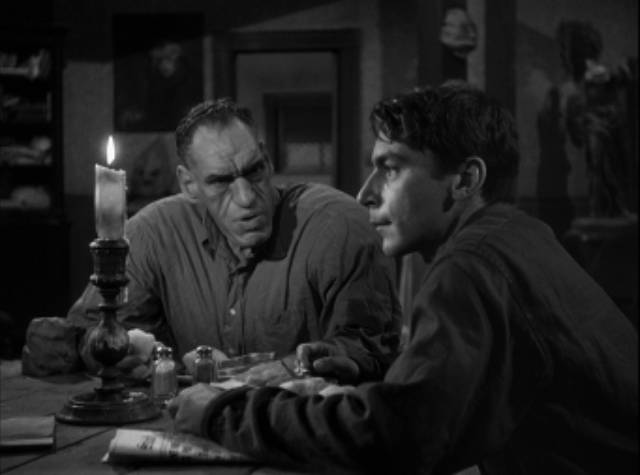
This little movie is interesting in a couple of ways, not least in prefiguring perhaps the greatest of Vincent Price’s movies, Douglas Hickox’s Theatre of Blood (1973), with its story of a self-deluded “artist” who takes murderous revenge on his critics. This, though, is not a comedy, but rather a moody horror with tinges of the noir which was becoming prevalent in the post-war industry. The artist is modernist sculptor Marcel De Lange (Martin Kosleck), starving in his run-down studio, who is savagely humiliated in the opening scene when a prospective buyer shows up with art critic F. Holmes Harmon (Alan Napier) to offer his opinion on the piece for sale. Harmon contemptuously dismisses it as trash and the sale falls through; De Lange can’t even afford to buy milk for his cat, so he wanders off into the night contemplating suicide.
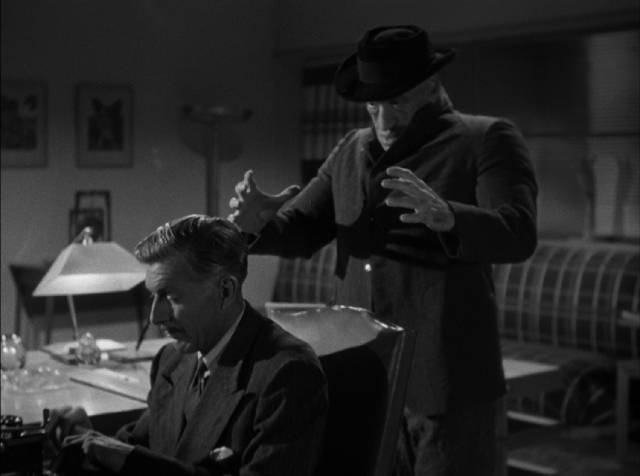
But as he stands staring at the river, he spots a body below. Dragging the almost-drowned man back to his studio, he discovers that he’s deformed and is inspired to sculpt an oversized bust which will be his masterpiece. What he doesn’t know at first is that this man is The Creeper, a notorious serial killer who has been terrorizing the city by crushing his victims’ spines. This character, for both positive and negative reasons, is the most interesting aspect of the movie because he’s played by Rondo Hatton. Hatton suffered from acromegaly, the same genetic condition as John Merrick, the Elephant Man, though his deformity was less severe.
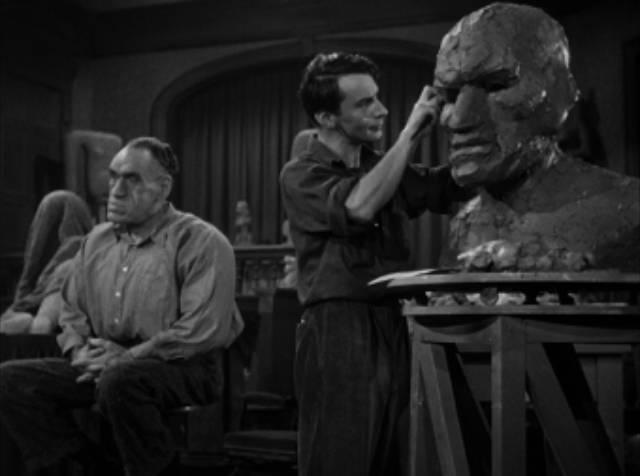
Hatton had been playing numerous uncredited bit parts throughout the ’30s until he had his first significant role in the 1942 Sherlock Holmes film Pearl of Death – as The Creeper, a villain who snapped his victims’ spines. Seeing something exploitable here, Universal tastelessly billed him as a “monster without makeup” and he began to get on-screen credits in such movies as The Jungle Captive (1945) and The Spider Woman Strikes Back (1946), though his biggest parts were as The Creeper in House of Horrors and its prequel The Brute Man (1946); he died of a heart attack before the latter was released, perhaps escaping the humiliation of seeing Universal dumping it on poverty row distributor Producers Releasing Corporation because they’d already become embarrassed by their exploitation of his condition.

While the company used him crassly, Hatton’s presence on-screen is much more interesting than a cheap horror prop. He’s suffused with a haunting sense of melancholy and while it’s not there in the script, we can feel a lifetime of humiliation and rejection behind his violent crimes – he evokes the same kind of empathy as Karloff’s misunderstood monster in Frankenstein, but with the added sting of knowing that what Hatton had to deal with extended off the screen into the real world. Though the movie wants us to sympathize to some degree with De Lange as he strikes out at the smug critical establishment which takes such pleasure in ruining an artist’s life, the sculptor’s exploitation of The Creeper echoes Universal’s use of Hatton to provoke a frisson in the audience. While Hatton had real screen presence, his condition limited what he was offered and allowed to do as a performer.
While House of Horrors is efficient and atmospheric, it’s Rondo Hatton’s presence, with its complicated issues of exploitation and representation, which makes it one of the most interesting of the later classic Universal horror movies. (De Lange’s sculpture of The Creeper became the basis for the Rondo Hatton award, which since 2002 has been given for achievements in the field of horror scholarship, journalism and preservation.)
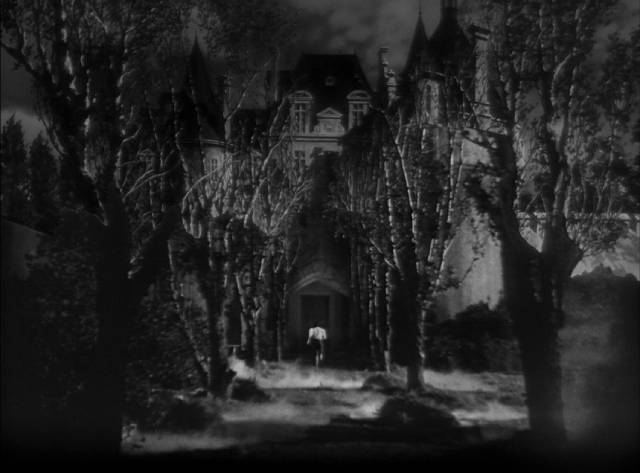
The Strange Door (Joseph Pevney, 1951)
The second wave of Universal horrors dried up in 1946, unless you count the Abbott and Costello Meet… comedies later in the decade and the early ’50s. But before the studio embarked on their successful run of science fiction movies which began with It Came from Outer Space (1953) and Creature from the Black Lagoon (1954), they produced a couple of period Gothics which seem quite different from the earlier movies – although there are dank dungeons and torture chambers, there are no monsters and nothing supernatural; in fact, the twisted psychology and sexual undertones make them seem like a precursor to Roger Corman’s Poe cycle and the Italian Gothic movies of the ’60s.
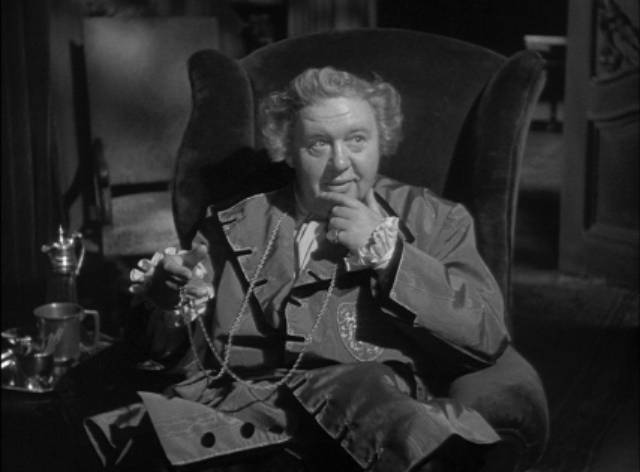
Directed by Joseph Pevney, who made some thirty features in the ’50s before settling into a long, busy career in television, The Strange Door (1951) was based on a story by Robert Louis Stevenson. Denis De Beaulieu (Richard Stapley) is a bit of a wastrel who gets into a fight in a tavern and apparently kills a man; fleeing a mob, he ends up in the country where he comes across a forbidding mansion and seeks shelter. What he doesn’t know is that his host, Sire Alain De Maletroit (Charles Laughton), has engineered the whole thing in order to entrap him. The decadent nobleman has sought what he sees as a disreputable and unsuitable man to marry his niece Blanche (Sally Forrest) as the final stage of a decades-long plan to get revenge for a romantic disappointment which has left him bitter and twisted.
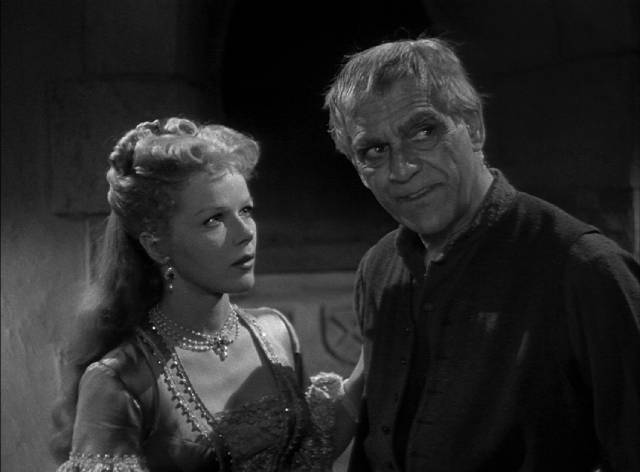
Twenty years earlier the woman he loved had instead chosen his brother Edmond (Paul Cavanagh) and had died in childbirth. Sire Alain had imprisoned Edmond in his dungeon and raised Blanche himself, and now he wants to marry her off to a worthless man as a final act of punishment. Unfortunately for him, Denis isn’t all that bad and he and Blanche fall in love, ruining his plan. Not only do they try to escape, they also discover that her father is still alive, having survived by pretending to be mad. When things look hopeless and Denis, Blanche and Edmond are about to be crushed by the walls of the dungeon closing in, they are saved thanks to the help of Alain’s servant Voltan (Karloff in a supporting role), who finally turns against his master.
Pevney keeps things moving along quickly, creating some effective atmosphere in the dungeon scenes, but the real appeal of the movie comes not surprisingly from Charles Laughton’s very ripe villain chewing the scenery to within an inch of its life.
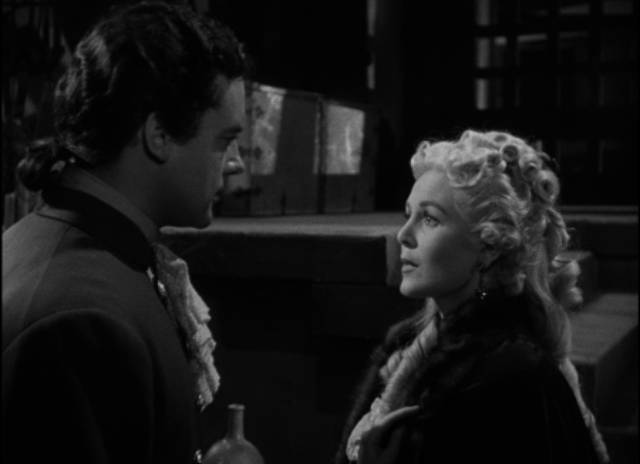
The Black Castle (Nathan Juran, 1952)
Made the following year, The Black Castle (1952) seems like a throwback to the swashbuckling epics of Douglas Fairbanks and Errol Flynn. The heroic protagonist is a British officer, Sir Ronald Burton (Richard Greene, just three years away from international fame as Robin Hood in the long-running television series), who under an assumed name makes his way to the castle of Count Karl von Bruno (Stephen McNally), whom he suspects of murdering two other officers. The Count is a sadist who terrorizes his wife, Countess Elga (Paula Corday), because he sees her as a possession. Needless to say, Burton and Elga fall in love, adding a complication to the Englishman’s mission.
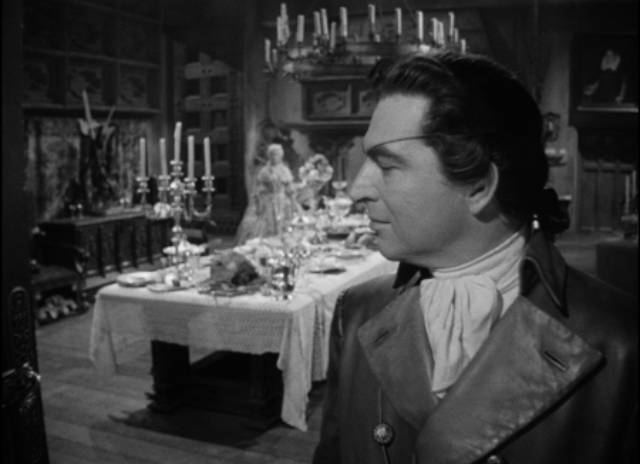
Karloff shows up again in a minor supporting role as Dr. Meissen, who despises the Count and does what he can to help the couple – including planning a Romeo and Juliet-style fake death for the couple which eventually goes wrong – and Lon Chaney Jr. makes an appearance as brutish servant Gargon, who like his master enjoys inflicting pain. There’s even a touch of The Most Dangerous Game when the Count invites Burton to join a hunt where the Englishman finds himself becoming prey.
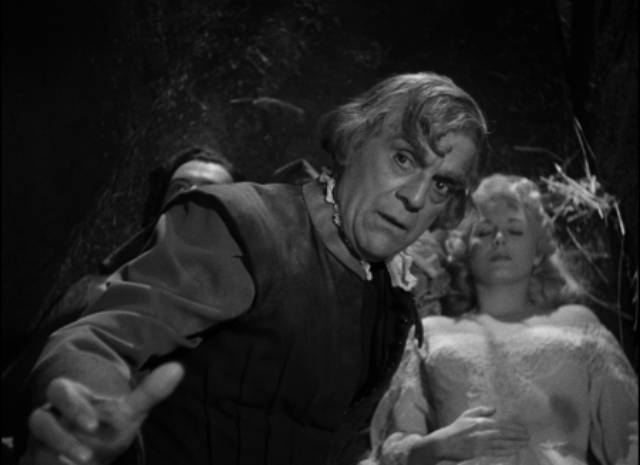
Atmospheric, with more detailed design than The Strange Door, The Black Castle was the first movie directed by Nathan Juran, a successful and prolific art director who went on to a twenty-year career directing features and episodic television in multiple genres – cheapies like The Deadly Mantis, The Brain from Planet Arous (both 1957) and Attack of the 50 Foot Woman (1958) to more prestigious movies like Ray Harryhausen’s The 7th Voyage or Sinbad (1958) and First Men in the Moon (1964). He landed the job on The Black Castle when original director Joseph Pevney dropped out over disagreements about the script and the studio needed a replacement to start shooting immediately. Juran, who had been hired as art director, knew the script so well that the job fell to him by default. He was obviously ready because the movie is one of the best-directed of his career.
Greene is an appealing hero, McNally an excellent villain, Corday a fine romantic heroine. Even if underused, Karloff and Chaney are welcome additions to the cast, with John Hoyt and Michael Pate providing strong support as two of the Count’s henchmen.
*
These ten movies are packaged in three two-disk sets by Eureka – Murders in the Zoo, Night Monster, Horror Island and House of Horrors in Creeping Horror; The Invisible Ray, Black Friday and The Strange Door in Karloff in Maniacal Mayhem; and Night Key, The Climax and The Black Castle in Universal Terror – all with pleasing transfers, supplemented by commentary tracks which pair Kim Newman and Stephen Jones or Kevin Lyons and Jonathan Rigby. There are trailers, and booklets with an essay on each film, plus three radio adaptations of Stevenson’s story “The Sire de Maletroit’s Door”. While none of these movies can match the first round of Universal horrors from the early ’30s, they almost all provide the solid entertainment audiences once expected from double-bills in their local theatres.
Comments
Kenneth, thanks for the great write-up about these Universal B movies. I’ve only seen a few of them so I need to hunt down the rest to watch. I have the well known Universal classics on laserdisc and dvd including laserdisc box sets of all of the Invisible Man and The Mummy sequals.
Some of the very first dvds I ever bought were Columbia House deals which allowed me to upgrade my Frankenstein, Dracula and The Mummy laserdiscs to dvd. I did keep all of the other movies on laserdisc.
Thanks for continuing to share your knowledge and reviews of your personal movie collection! Now I have some interesting movies to track down and watch!
It’s hard to believe anyone was ever scared by these movies, but I love them for the wit and style.